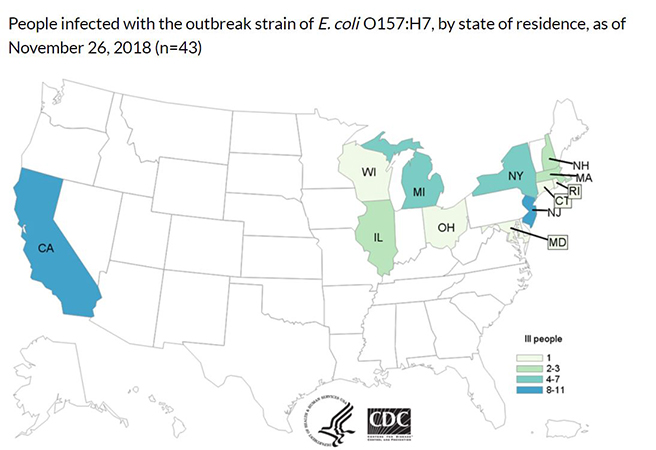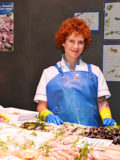 Based on new information, CDC is narrowing its warning to consumers. CDC is advising that U.S. consumers not eat and retailers and restaurants not serve or sell any romaine lettuce harvested from the Central Coastal growing regions of northern and central California. If you do not know where the romaine is from, do not eat it.
Based on new information, CDC is narrowing its warning to consumers. CDC is advising that U.S. consumers not eat and retailers and restaurants not serve or sell any romaine lettuce harvested from the Central Coastal growing regions of northern and central California. If you do not know where the romaine is from, do not eat it.
The U.S. Food and Drug Administration, along with the Centers for Disease Control and Prevention and state authorities, continues to investigate a multistate outbreak of E. coli infections associated with consumption of romaine lettuce in the U.S.
As of November 26, 2018, this outbreak has resulted in 43 people becoming ill in 12 states, with the last reported illness onset date being October 31, 2018. An additional 22 people in Canada have become ill, and the FDA and their partners are also coordinating the investigation with Canadian health and food safety authorities.
As the investigation of this outbreak continues, the FDA announced new steps to help consumers better identify where their romaine is grown through voluntary labeling.
Toss the romaine
To prevent additional cases of E. coli, the CDC advised the public not to consume romaine lettuce and to destroy any romaine lettuce in their homes.
At the same time, the FDA requested that all romaine lettuce on the market, including in restaurants and other commercial establishments, should be withdrawn and destroyed. The FDA made this request because initial information available at that time had not identified a likely source for the outbreak that would allow a targeted request, it was likely romaine lettuce contaminated with E. coli that could cause illness was still available on the market, and a market withdrawal was the fastest way to remove potentially contaminated product.
The romaine lettuce industry agreed to comply with the FDA’s request to withdraw any romaine lettuce on the market on that date, and available information suggests this action was effective in removing potentially contaminated romaine lettuce from retail establishments.
 Where is the lettuce coming from?
Where is the lettuce coming from?
Over the Thanksgiving holiday, the FDA continued to investigate the outbreak. The investigation at this point suggests that romaine lettuce associated with the outbreak comes from areas of California that grow romaine lettuce over the summer months, and that the outbreak appears to be related to “end of season” romaine lettuce harvested from these areas. The involved areas include the Central Coast growing regions of central and northern California.
The FDA is continuing tracebacks of romaine lettuce from locations where impacted consumers purchased or consumed romaine lettuce before they became ill in order to identify specific locations that are the likely source of the outbreak and to determine the factors that resulted in contamination.
Through laboratory studies they have identified that the E. coli O157:H7 strain causing the outbreak is similar to one that produced an outbreak of E. coli O157:H7 in the fall of 2017 that also occurred in the U.S. and Canada, which was associated with consumption of leafy greens in the U.S. and specifically romaine lettuce in Canada.
Based on further discussions with the leafy greens industry and with agricultural authorities, they have begun to narrow the location in which they believe the contaminated romaine in the current outbreak was grown. At the time of the outbreak, the vast majority of the romaine on the market was being grown in the Central Coast region of California.
Since, then harvesting of romaine lettuce from this region has ended for the year. Growing and harvesting of romaine lettuce is now shifting to the winter growing regions of the U.S., which include mainly the California desert region of the Imperial Valley, the desert region of Arizona in and around Yuma, and Florida.
What about lettuce coming from other areas?
Romaine lettuce grown in Mexico is exported to the U.S. during the winter months. Smaller quantities of romaine lettuce are grown in other states. At this time, the FDA has no information to suggest any of these growing areas are involved in the current outbreak, which began well before any romaine lettuce from these winter growing locations was available for harvest.
In addition, hydroponic romaine lettuce and romaine lettuce grown in green-houses is also marketed in the U.S., but there is no information to suggest these products are implicated in any identified E. coli O157:H7 outbreak.
Markets purged of risky romaine
The FDA believes it was critically important to have a “clean break” in the romaine supply available to consumers in the U.S. in order to purge the market of potentially contaminated romaine lettuce related to the current outbreak. This appears to have been accomplished through the market withdrawal request of Nov. 20, 2018.
Based on discussions with major producers and distributors, romaine lettuce entering the market will now be labeled with a harvest location and a harvest date. Romaine lettuce entering the market can also be labeled as being hydroponically or greenhouse grown.
If it does not have this information, you should not eat or use it.
If consumers, retailers, and food service facilities are unable to identify that romaine lettuce products are not affected – which means determining that the products were grown outside the California regions that appear to be implicated in the current outbreak investigation – The FDA urges that these products not be purchased, or if purchased, be discarded or returned to the place of purchase.
Romaine lettuce that was harvested outside of the Central Coast growing regions of northern and central California does not appear to be related to the current outbreak. Hydroponically- and greenhouse-grown romaine also does not appear to be related to the current outbreak.
Facts and Tips
Romaine lettuce products will be labeled with a harvest location by region. It may take some time before these labels are available.
If the romaine lettuce is not labeled with a harvest growing region, do not buy, serve, sell, or eat it.
Check bags or boxes of romaine lettuce for a label indicating where the lettuce was harvested. Romaine lettuce labeled with a harvest region outside of the Central Coastal growing regions of northern and central California (such as the desert growing region near Yuma, the California desert growing region near Imperial County and Riverside County, the state of Florida, and Mexico) is not linked to this outbreak.
If you do not know where your romaine lettuce was harvested, do not eat it and throw it away. This advice includes all types or uses of romaine lettuce, such as whole heads of romaine, hearts of romaine, and bags and boxes of precut lettuce and salad mixes that contain romaine, including baby romaine, spring mix, and Caesar salad.
If you do not know if the lettuce is romaine or whether a salad mix contains romaine, do not eat it and throw it away.
Wash and sanitize drawers or shelves in refrigerators where romaine was stored. Follow these five steps to clean your refrigerator.
Restaurants and retailers should check the label on bags or boxes of romaine lettuce, or ask their suppliers about the source of their romaine lettuce.
- Do not sell or serve any romaine lettuce harvested from the Central Coastal growing regions of northern and central California.
If you do not know where your romaine lettuce was harvested, do not sell or serve it. - Hydroponically or greenhouse-grown romaine lettuce has not been linked to this outbreak.
- Take action if you have symptoms of an E. coli infection:
- Talk to your healthcare provider.
- Write down what you ate in the week before you started to get sick.
- Report your illness to the health department. Assist public health investigators by answering questions about your illness.











